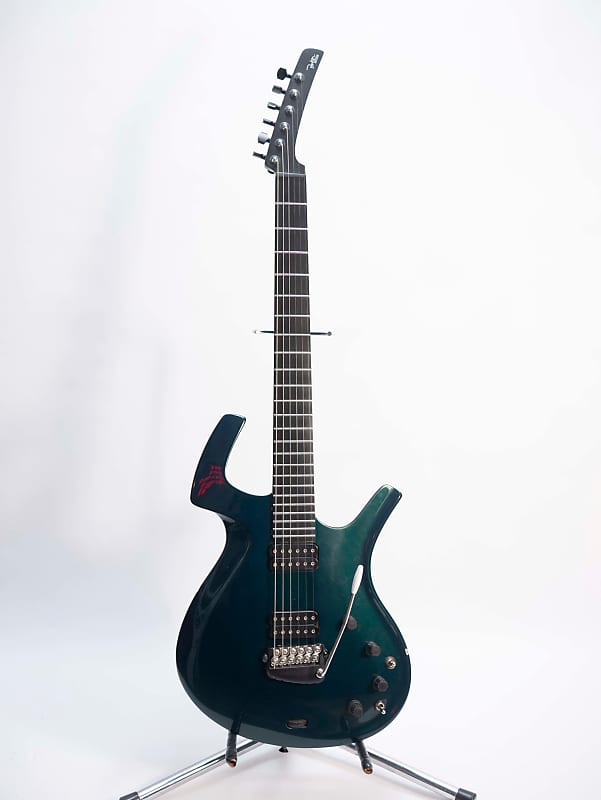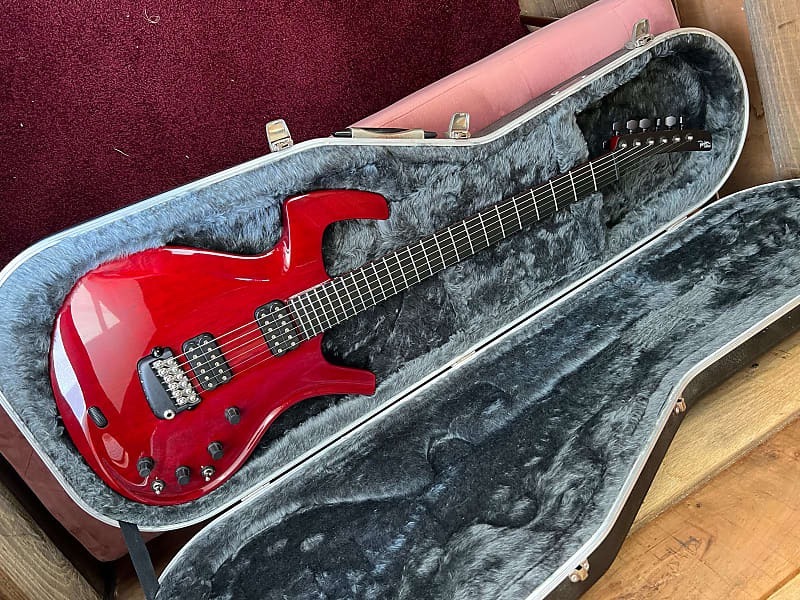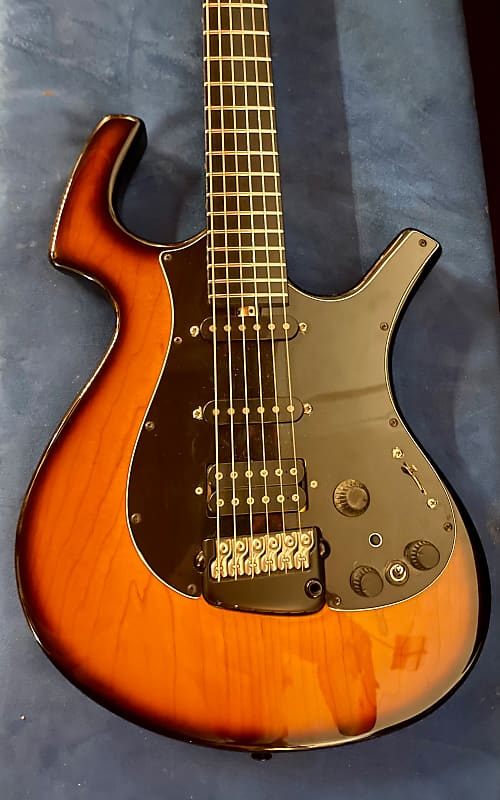The Parker Concert guitar that Ken Parker gave to Joni Mitchell came out of a trash can. One of a handful of Parkers made in Western red cedar, it had developed a small crack and was sitting in a barrel of oh-well guitars at the factory in Wilmington, Massachusetts.
Ken’s friend Fred Walecki at Westwood Music in California told Ken that Joni was looking for a lightweight guitar. Parker guitars certainly fit that description. Ken said he’d send her one.
"I fixed up the crack," Ken told me when we chatted for my book about guitar design. Then he gave the instrument what he calls a more organic-friendly finish than usual, and added a Roland hex-output pickup so Joni could use it with a Roland VG-8 processor to facilitate her fondness for alternative tunings.

Ken sent the finished guitar to Joni, and he remembers the call that came soon afterward. "She said, ‘Looks like you found it on a beach. But then it also looks like it came from outer space.’ I always liked the idea that it looked like a bleached bone, or driftwood, I guess. And that guitar just worked like a magic wand for her. She performed exclusively with my guitar for six years, and that makes me very proud."
Ken had started out making archtop acoustic guitars, in the late '70s. He loved this work but he couldn’t make a living. He figured that if he was going to carry on as an instrument maker, he’d have to make stuff that appealed to musicians who made money. So, electric guitars beckoned.
It took about ten years of research and development to get to the point where the first Parker Fly guitars appeared, and early on in that process—around 1984—Ken had been fortunate enough to hook up with Larry Fishman. When they met, Ken was the instrument maker, Larry the pickup maker, but that division soon melted away. They worked gradually toward a new kind of electric guitar.
"I didn’t feel like I had some secret broth that I could smear on a Strat," Ken recalls. "In retrospect, that just hasn’t been a good way forward for people. That’s like trying to improve on a smile. I mean, what do you do? It’s already developed."
Instead, they designed an electric guitar that was, as Ken describes it, as responsive and interesting to play as an acoustic instrument. Instead of thinking of an electric guitar as a non-acoustic guitar, he simply considered it as a quiet acoustic guitar.
"If you have a terrible-sounding electric guitar, no pickup will fix it," he says. "If you have a great-sounding electric guitar, any pickup will be OK. This is where the original idiocy came from that an electric guitar is just this irrelevant mass of junk with the all-important magnetic pickup screwed to it. That couldn’t be further from the truth."
Ken and Larry would say to each other that if the job before them was easy, then somebody would already have done it. "And that’s how you start a guitar company," Ken says with a weary smile. "You just think you’ve got a better idea. You’ve got more energy! You’re just going to get it done by sheer force of will! Otherwise, a reasonable person would talk you out of it in about five minutes."

Photo by Cosmic Ooze Sonic Overlords.
No reasonable person dissuaded them, and in 1993 Ken and Larry found themselves with a guitar company, a factory in Massachusetts, and a new guitar to sell, the Parker Fly, named because compared to other solidbody electrics it was light as a fly.
Korg’s US subsidiary was looking for a guitar company to put alongside its other instruments and gear, and eventually they made a deal. Looking back, Ken describes the project as almost comically underfunded. "But we had enough confidence and hubris, I guess, to believe that this was an equation we could solve for profitability. We took the money and we did the best we could."
At the time, Ken described the purpose of the new Parker Fly as not to create something different, but rather to create something more versatile. He’d concluded that the material used for the body of a guitar is more important than most makers gave it credit for, that the tone of the body material was essential to the tone of the amplified instrument. He tells me they demonstrated that by the fact that their models were differentiated by the body materials used—and those different materials were chosen for their tone.
He designed the Fly so that the wooden neck and body flowed into one another in an organic shape and then were unified on the rear with a thin external skeleton of carbon, fiberglass, and epoxy resin, which remained supple enough to respond like an acoustic guitar. The fingerboard and headstock veneer were made of the same reinforced plastic.
The conical-surface fingerboard—usually known as a compound-radius fingerboard—had bonded tang-less frets, and the guitar came with a self-lubricating nut and locking tuners. It was offered with an optional integral piezo pickup, and a multi-function vibrato. The regular magnetic pickups and controls were conventionally placed, and the piezo-equipped option increased the array of knobs and switches.
A good deal of the Fly’s design was intended to reduce the weight of the instrument and maximize its ability to work with the energy created by the strings. The result was visually striking, too, not least with those angular body horns and the narrow, minimal headstock. The instrument had an instant identity.
That minimal headstock was one of the Fly’s key elements. Ken’s influences were ancient uds and lutes with heads made as small and light as possible. Their makers had done everything possible to encourage these acoustic instruments to bark and make their presence known.

"In those circumstances," Ken says, "one of the things you need to do is reduce the weight of the vibrating object so you can accelerate the very small amount of energy you have in a little bitty string. You want to make the headstock as small and as stiff and as light as you can, so that it doesn’t turn into an unwanted oscillator—which is the root of all dead spots. Also, you want to make the neck as stiff as it can be, to resist being modified by the position or the size of the player’s hand."
As production picked up in the early ‘90s, a few problems arose, for example in the finishing process. Part of the guitar had a wooden surface, which has its own challenges for painting, and part had a carbon fiber surface, with its own demands and idiosyncrasies and quirks for finishing.
"Most people are surprised to learn that finishing a guitar can take about 50 percent of the cost of producing it," Ken says. "Well, here it was probably 80 percent for a while." He added that the joke at Parker in 1993 was that black was a custom color—because that was the only color they could successfully paint. White proved to be the most difficult: one speck and it was ruined.
As the years went by, Parker offered variations on the original Fly, including the cheaper bolt-on Nitefly, the piezo-only Concert, the nylon-string Spanish, and the synth-access MIDI Fly. However, despite strong player-centric attributes and distinctive visual hallmarks, the guitars struggled to make a mark (or a profit). Korg pulled out in 2000, and U.S. Music Corp—which owned Washburn among other brands—bought Parker Guitars in ’03. Ken and Larry left, and U.S. Music produced its own line of different Parker-brand guitars until 2015.

Photo by Doug's Brilliant Instruments.
The original Parkers offer an intriguing glimpse of what an electric guitar might be, and they still have the ability to make you think carefully about the ways an electric can feel and respond and sound. Mary Chapin Carpenter demonstrated that at a show Ken and some of his colleagues attended in the ’90s. She played her first half dozen songs on Martin and Guild flattops. Then she picked up her Parker Concert model, the one with the spruce body and no magnetic pickups, just the piezo.
Mary hit a G chord to make sure her Parker was working before she began the song. "It sounded just so beautiful," Ken recalls. "The whole crowd made a gasp. The other people there with me from my shop turned to look at me, their eyes like giant fish eyes. They all just went ‘Holy shit!’ I thought: Even the crowd knows this guitar is better. They voted with a gasp, a drawn breath. I guess if you’d had a barometer, you could have measured the pressure dropping." Moments like that made it all worthwhile.
During the years he spent at Parker Guitars, from 1981 to 2003, Ken saw around 30,000 guitars ship from the factory. "I’m not the first person who came out with something they didn’t know how to sell," he says in conclusion. "Or the first to come out with a good idea that was just too complex for the market. That’s really what I think I did. I was building to that 85th percentile on the bell curve. And everybody below that said, ‘Well, why are there so many knobs on it?’ And then they would walk away. It turns out, ultimately, that the world doesn’t really have a need for all guitars to be at the top of the bell curve."
These days, you can find Ken full circle, making acoustic archtops again, at Ken Parker Archtops in Gloucester, Massachusetts. The fine guitars he makes today have an enviable reputation. A friend asked him why, though, are they so expensive? He replied with what he called the short answer. One word, in fact. Goosebumps. Slightly longer answer? You don’t forget the feeling you get the first time you play a great guitar.
About the author: Tony Bacon writes about musical instruments, musicians, and music. His books include History Of The American Guitar and Electric Guitars: Design & Invention. Tony lives in Bristol, England. More info at tonybacon.co.uk.
